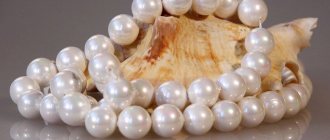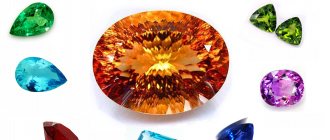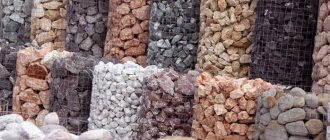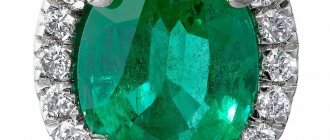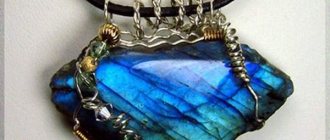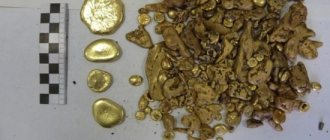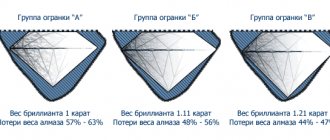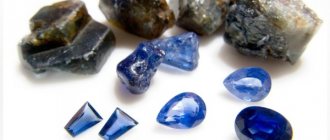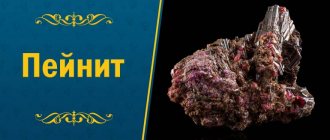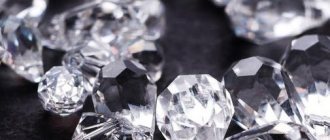MINI GUIDE TO BUYING PRECIOUS STONES
Understanding the value of colored stones is very important for a successful purchase, but examination and evaluation is by no means an easy task. Indeed, in the evaluation of colored gemstones, the subjective factor plays a much more significant role than in the evaluation of diamonds. It is very important to know the 4C's rule (Color, clarity, cut and carats) - only understanding the “relationships” of color, clarity, cut quality and carat weight will allow you to correctly and realistically evaluate a particular stone.
I. Color
“I think it really hurts God if you walk around dressed in purple and no one notices.” Alice Walker
Color is the most important factor in determining the value of colored gemstones, and most dealers estimate the color component in the value of a stone to be between 50 – 70% of the full value. In general, bright, rich, intense and pure color is always better than dull, non-intense... Gemstones should not be too dark or too light. Ideally, they should look good in any light. Colored stones with a color changing effect should show a strong change under different lighting. It is imperative to take into account that the visible color of the stone always depends on the type of lighting. Even in daylight, the same stone can look different because the intensity of daylight varies throughout the day and depends on latitude. Morning, midday and evening light have their own characteristics, sometimes greatly affecting the appearance of the stone. Just like natural daylight, artificial light also has a very significant effect on the visible color of the stone. For example, incandescent lamps add red tones to stones, while a fluorescent lamp makes the stone “greener” or “blue.” In order to correctly describe the color of a stone, experts use various lighting sources that allow them to obtain light with different temperatures. Standard temperatures of light for various minerals have long been studied by specialists in the field of optics and crystallography. When purchasing stones online from photographs, you must be very careful, as the vast majority of unscrupulous dealers use incorrect lighting when photographing stones. This happens either out of ignorance, or in order to inflate prices for an unsuspecting buyer, or to sell inexpensively a stone that is not worth even what they ask for it.
We must not forget one more very important detail: no matter what effect the color has on the cost of the stone, no matter what opinion a gemologist expresses about it, YOU will be the one wearing jewelry with the purchased stones!!! Therefore, your personal preferences are most important when choosing the color of gemstones.
Pricing for stones from our collection
Constantly monitoring the global stone market, we operate with the most current data, and the network of our international partner dealers allows us to find unique samples at the best prices. This means that the stones from our collection are a balanced combination of quality and cost. It is also important to note that we do not focus on Russian prices for individual colored stones, because they are often many times higher. In our pricing, we rely only on world prices for stones, current global demand and the latest information on the state of deposits. We are happy to share our forecasts with you, talk about market trends and all the subtle nuances that affect the value at the moment.
II. Purity
“I’m just a handsome, neatly hewn Mongolian boy.” Yul Brynner
The purity of colored gemstones is only the second most important factor when evaluating them. Natural colored stones are almost never as pure as diamonds, and they cannot be graded using the same criteria as diamonds. Popular and expensive gemstones such as emeralds, rubies and alexandrites are extremely rare to be pure. Cleanliness and transparency are of course always desirable, but color is still of paramount importance. Precious stones have different chemical compositions, different crystal structures, and grew and matured in different geological conditions. Some of them are never clean and completely transparent. And if from Amethysts, Topazes, Citrines, Kunzites, Tanzanites, yellow Beryls and Chrysoberyls one can still expect the absence of inclusions visible to the naked eye, then it is difficult or even very difficult to count on this for Alexandrites, Sapphires, Rubies, Andalusites, Iolites, Garnets, Spinels, Tourmalinov ... Well, if you're lucky, get ready to pay a serious price...
In some cases, very strong inclusions in stones are not a disadvantage, but rather an advantage, and significantly increase the value of the stone. The best star sapphires and rubies, chrysoberyls and cat's eye scapolites are usually almost opaque. These stones are very strongly included, but microscopic in size inclusions reflect light in a special way and produce these effects - a “multi-beam star” or “cat’s eye”.
Personalized Jewelry
With any stone purchased from our company, we offer to make jewelry in our own full-cycle production. This will protect you from poor quality workmanship or the risk of damaging the stone during the setting process, because our jewelers are high-level professionals and constantly work with rare and valuable colored stones. Our jewelry workshop is currently one of the best in Moscow. We use Italian equipment and the hands of the most talented jewelers with over 15 years of experience.
We wish you to receive aesthetic pleasure from viewing our collection on the website, or better yet, we are waiting for you in our boutique, where we will be happy to show you the entire collection of stones and jewelry!
III. Cut
“Born in fire, blown with a mouth and given its shape by hands and heart.” Waterford glass
The most common method of cutting a gemstone is to turn its surface into a series of planes, which we call facets, or facets. They are the ones who give the stone its final shape. After cutting, polishing is applied - the oldest known method of treating the surface of a stone. It is the cut that gives a gemstone its beauty and brilliance. With an ideal cut, the stone reflects and refracts almost the entire stream of light passing through it. The angles and relative positions of the edges are of utmost importance; the “brilliance” of the stone depends on this.
Why doesn't every stone have the perfect cut and proportions?
Nature gives us raw materials in a very wide variety of shapes and sizes. Many crystals can be very flat and bulky. Only through experience and talent can a cutter attempt to maximize results and produce the largest stones in size and weight from the material available. Since gemstones are sold by weight, larger stones typically cost more than smaller stones. The price for 1 carat of large stones is usually higher than for small ones. That is why the cutter always tries to squeeze the maximum size and weight out of the available material. In this case, inclusions, bubbles, shells, cavities can often appear on the surface of the stone, and in order to hide them, the cutter has to neglect ideal proportions.
What can be said about voids and bubbles in gemstones?
Professional conscientious jewelers, gemologists and dealers will always report the presence of voids or bubbles when describing or selling a gemstone when assessing its clarity... Voids and bubbles in gemstones are something that can be easily noticed, especially in overly flat stones.. Voids and bubbles cause a decrease or complete absence of reflection and refraction of light in the center of the stone, and this leads to a decrease in shine and a deterioration in the “game” of the stone.
Why are gemstones with voids and bubbles still produced and sold?
The answer is very simple! Some stones are so rare in large sizes that they cannot be neglected even though there are voids and bubbles! Encumbered by a bubble or void inside, a 3-carat Burmese ruby will almost always cost more than a perfect 1-carat ruby cut from it! There are no generally accepted standards for assessing the quality of cut colored stones. This criterion is the most subjective for any expert. In fact, everything depends only on the cutter himself. This is a profession that you can learn, but you can’t become one of the best in it if you don’t have a talent given from above.. They say that one becomes a cutter, but a cutter , one is born.. The greater or lesser degree of visibility of inclusions, the play of the stone do not depend on the opinion of an expert , not from the skill of the jeweler, but only from him - from His Majesty - the Talented Cutter !!!
Does cut affect the color intensity of a gemstone?
You often hear this question.. And the answer to it is also very simple. Of course it does, and how! Any gemstone will not only become lighter if you reduce its size. The color saturation will also change. Any stone looks lighter when its size decreases, and darker when its size increases. Cutters, taking into account many factors in their work, including this one, often cut not one large stone from a very dark material, but several medium ones or many small ones. Moreover, their total value, thanks to the best color, exceeds the value of 1 large one! And for light stones - everything is the same, but just the opposite... You can pick up, for example, a couple of topaz... One is small, a few millimeters, the other is a cobblestone of a hundred carats. To the uninitiated eye, these two stones will appear to be completely different colors - a pale sickness blue and a bright blue stone! But in fact, both have the same color, only their apparent intensity and saturation differ.. Unfortunately for all of us, even in the purest transparent diamond, some part of the light flux is not only refracted and reflected, but also scattered and absorbed.. The darker the stone , the greater the degree of color dispersion and absorption. The more light that is absorbed or scattered, the darker the stone appears. We value precious stones for their beauty, for their color, for their “game”. Stones with pure bright colors and good clarity are very rare. Sometimes a specialist sees that he has a stone in his hands that has already been cut. But - unsuccessfully cut... Often such stones are given to an experienced cutter for recutting. As a result, even taking into account the loss of 30-50% of weight, much more beautiful and valuable stones are obtained.
IV. Weight (carat)
“Don’t expect to buy cheaply what is worth the price of gold triple its weight...” John Bartlett.
A carat is a metric unit of weight used to describe the weight of a gemstone. A carat is equal to one fifth of a gram and there are five carats in one gram. Gemstones are most often sold by weight rather than by size. Less valuable materials, or, conversely, the most valuable ones, can be cut into calibrated standard sizes commonly used by jewelry makers. The cost of 1 carat of large gemstones is always higher than 1 carat of small ones of similar quality. The price ratios for 1 carat depending on the weight are different for different stones. But on average, we can offer the following scale:
(1/2 – 1cts) = price ($x/cts).
(1 – 2cts) = price ($2 x/cts.)
(2 – 3cts) = price ($4 x/cts.)
(3cts. +) = price ($4-5x/cts. +)
(5cts. +) = significant multiple price change.
The weight of a stone depends on its size, but for each type of stone this dependence is purely individual. All precious stones have different densities, and the mass per unit of their volume depends on this indicator. There are very light stones, such as opal, and there are particularly heavy stones, such as sphalerite or zircon. For example, a round 1-carat diamond with ideal proportions would have a diameter of 6.25mm. An opal of the same exact shape and size will weigh 0.70 carats, and a zircon will weigh 1.40 carats.
What are semi-precious stones
Minerals that have a beautiful appearance are called semi-precious. They are used to create jewelry, collected, and turned into banking assets. They are found in nature often, but in certain places. Thus, the deposit of some rocks is only one point on the map, while others are found throughout the world. The cost depends on the volume of rock found and its hardness on the Mohs scale from 1 to 10, where the hardest (10) is diamond.
In Russia, only diamond, blue sapphire, emerald and natural pearls are considered precious. The rest are equated to semi-precious ones, although products with them are not always cheap, and sometimes the cost is even higher. Semi-precious stones are popular not only among women, but also among men. They are credited with magical and healing properties and are worn according to the zodiac sign. In general, semi-precious minerals have occupied a certain niche in the world of jewelry and delight their owners not only with beauty, but also with properties.
